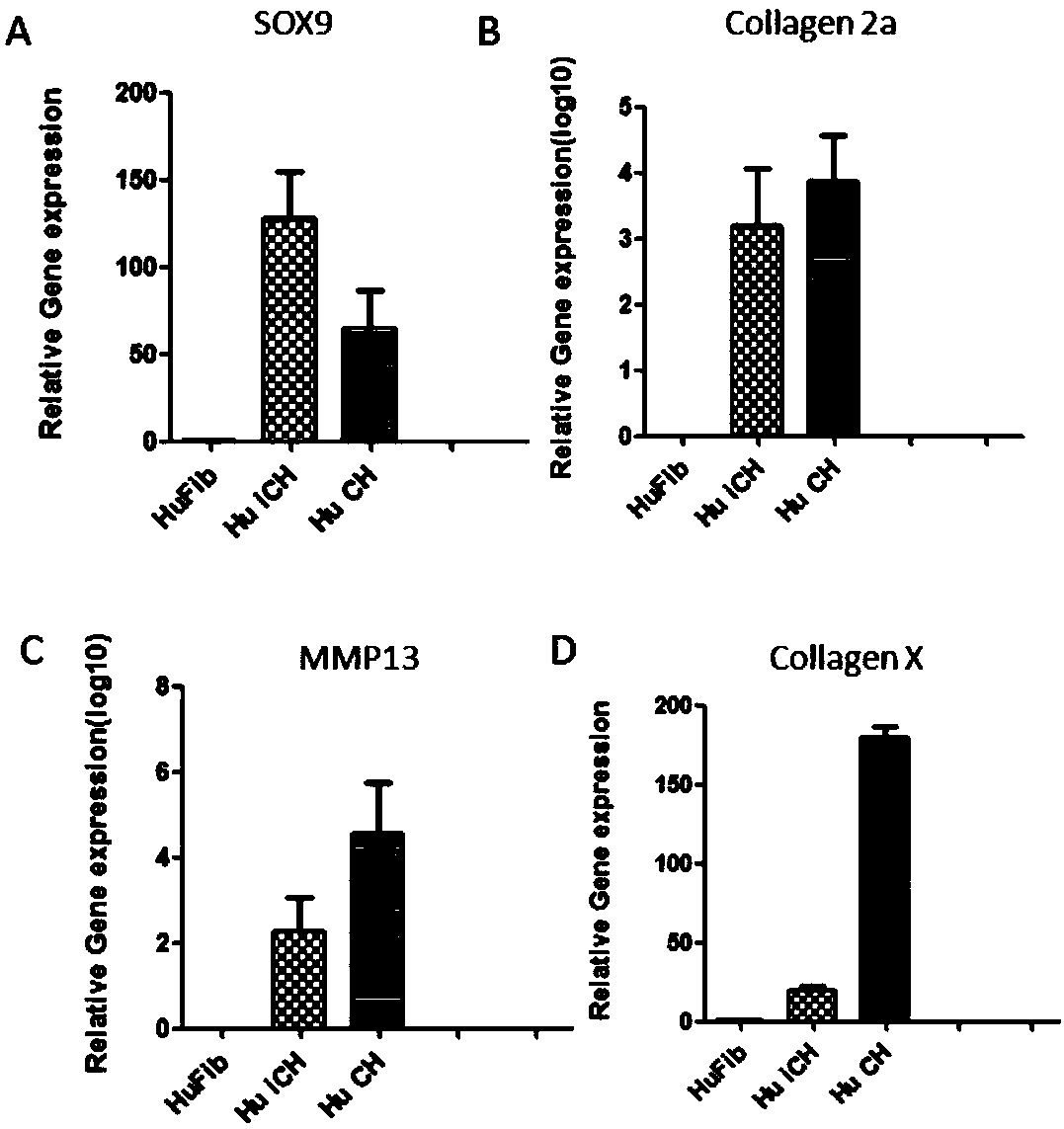Small-molecular compound combination and method for inducing differentiated cells to prepare chondrocytes by using small-molecular compound combination
A small molecular compound and chondrocyte technology, applied in the field of cell biology, can solve the problems of cell induction and transdifferentiation, and the feasibility of transdifferentiation of similar cells is not high
- Summary
- Abstract
- Description
- Claims
- Application Information
AI Technical Summary
Problems solved by technology
Method used
Image
Examples
Embodiment 1
[0156] 1. Isolation of skin fibroblasts
[0157] 1.1 Obtain a skin tissue block with a diameter of about 1 cm from the donor, separate the skin fibroblasts by the adherent method, and culture the separated cells in the basal culture medium: 10% fetal bovine serum (Hyclone) + 100U / ml penicillin (Sigma) + 100 μg / ml streptomycin (Sigma) + high glucose DMDM.
[0158] 1.2 Subsequent passage of cells to a large number of expansion, the number of cell generations between the 6th and 12th passages is used for the induction of transdifferentiation into chondrocytes. The day before initiation of differentiation (Day-1), inoculate cell density at 1-2.5×10 4 / cm 2 Cultured at 37°C, 5% CO 2 in the incubator.
[0159] 2. The first stage induction of skin fibroblasts
[0160] After the treatment in the second step above, completely replace it with the second-stage culture medium for cell culture. The culture time is 6-12 days, at 37°C, 5% CO 2 environment to grow cells. The second st...
Embodiment 2
[0168] 1. Isolation of skin fibroblasts
[0169] 1.1 Obtain a skin tissue block with a diameter of about 1 cm from the donor, separate the skin fibroblasts by the adherent method, and culture the separated cells in the basal culture medium: 10% fetal bovine serum (Hyclone) + 100U / ml penicillin (Sigma) + 100 μg / ml streptomycin (Sigma) + high glucose DMDM.
[0170] 1.2 Subsequent passage of cells to a large number of expansion, the number of cell generations between the 6th and 12th passages is used for the induction of transdifferentiation into chondrocytes. The day before initiation of differentiation (Day-1), inoculate cell density at 1-2.5×10 4 / cm 2 Cultured at 37°C, 5% CO 2 in the incubator.
[0171] 2. Pretreatment of skin fibroblasts
[0172] 2.1 When starting transdifferentiation (Day0), completely replace the basal culture medium with the first-stage culture medium, and culture the cells for 4 to 6 days. The first-stage culture medium refers to: 10% fetal bovine ...
Embodiment 3
[0182] 1. Isolation of skin fibroblasts
[0183] 1.1 Obtain a skin tissue block with a diameter of about 1 cm from the donor, separate the skin fibroblasts by the adherent method, and culture the separated cells in the basal culture medium: 10% fetal bovine serum (Hyclone) + 100U / ml penicillin (Sigma) + 100 μg / ml streptomycin (Sigma) + high glucose DMDM.
[0184] 1.2 Subsequent passage of cells to a large number of expansion, the number of cell generations between the 6th and 12th passages is used for the induction of transdifferentiation into chondrocytes. The day before initiation of differentiation (Day-1), inoculate cell density at 1-2.5×10 4 / cm 2 Cultured at 37°C, 5% CO 2 in the incubator.
[0185] 2. Pretreatment of skin fibroblasts
[0186] 2.1 When starting transdifferentiation (Day0), completely replace the basal culture medium with the first-stage culture medium, and culture the cells for 4 to 6 days. The first-stage culture medium refers to: 10% fetal bovine ...
PUM
 Login to View More
Login to View More Abstract
Description
Claims
Application Information
 Login to View More
Login to View More - R&D
- Intellectual Property
- Life Sciences
- Materials
- Tech Scout
- Unparalleled Data Quality
- Higher Quality Content
- 60% Fewer Hallucinations
Browse by: Latest US Patents, China's latest patents, Technical Efficacy Thesaurus, Application Domain, Technology Topic, Popular Technical Reports.
© 2025 PatSnap. All rights reserved.Legal|Privacy policy|Modern Slavery Act Transparency Statement|Sitemap|About US| Contact US: help@patsnap.com



